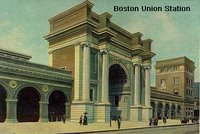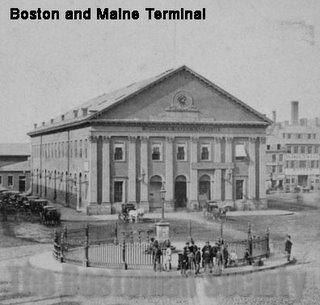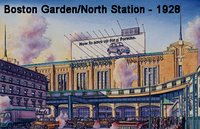Boston Railroading Lives On...
I was digging around the net today, looking for some information regarding the history of
NORTH STATION Located today at the corner of Causeway and Nashua Streets,
Located today at the corner of Causeway and Nashua Streets,
-The Boston and Maine Railroad, the major railway network of Boston and greater New England during the day
-The Boston and Lowell Railroad, one of the first railroads in North America and the first major one in New England
-The Eastern Railroad
-The Fitchburg Railroad, which ran through northern Massachusetts
Union Station was demolished in the late 1920s to give way to Boston Garden, built in 1928 and  later home of the Boston Celtics and the famous parquet basketball court. Directly beneath thed arena was the replacement for Union Station, known as Boston North Station (to distinguish it from another major railroad hub in the city, South Station). Trains departed from beneath the arena and continued across the
later home of the Boston Celtics and the famous parquet basketball court. Directly beneath thed arena was the replacement for Union Station, known as Boston North Station (to distinguish it from another major railroad hub in the city, South Station). Trains departed from beneath the arena and continued across the
 Station find themselves waiting for trains in a large, dimly lit lobby infested with pigeons, facing about a dozen parallel tracks. Escalators to the arena above are walled off from the passenger area by means of movable walls, and ticketing offices for sports events at the arena are just around the corner from the terminal waiting area. One is forced to wonder why the designers of a modern arena would locate ticketing offices
Station find themselves waiting for trains in a large, dimly lit lobby infested with pigeons, facing about a dozen parallel tracks. Escalators to the arena above are walled off from the passenger area by means of movable walls, and ticketing offices for sports events at the arena are just around the corner from the terminal waiting area. One is forced to wonder why the designers of a modern arena would locate ticketing offices
and access to the arena in the same vicinity as a busy commuter train terminal waiting area!
North station today serves as the terminus for Amtrak's Downeaster' route, which follows the old Boston and Maine right-of-way to Portland, ME. The station's main use, however, is as the north terminal of the MBTA's extensive Commuter Rail system, which operates trains throughout eastern MA. While the station resembles nothing of the Union Station of 1893, the railroads of 110 years ago still are used as commuter rail routes, including the Fitchburg Line (Fitchburg RR), the Lowell Line (Boston and Lowell RR), the Newburyport/Rockport Lines, and the Haverill/Reading Lines.

(above) An Amtrak Downeaster' train waits at North Station platform for departure; the drawbridge trestle over the Charles River is visible just beyond the platform.
SOUTH STATION
Unlike North Station, Boston's South Station, built in 1899 at Summer Street and Atlantic Avenue, has suffered less alteration and destruction through the past century. At the time of its completion, it was touted as one of the largest railroad stations in the world, and certainly the busiest passenger station in North America. Similarly to Union Station, South Station replaced smaller passenger railroad terminal buildings in the immediate area:
Avenue, has suffered less alteration and destruction through the past century. At the time of its completion, it was touted as one of the largest railroad stations in the world, and certainly the busiest passenger station in North America. Similarly to Union Station, South Station replaced smaller passenger railroad terminal buildings in the immediate area:
-The New York and New England Railroad, a major link with Providence, RI and New York State
 -The Old Colony Railroad, which ran to the tip of Cape Cod (Provincetown, MA)
-The Old Colony Railroad, which ran to the tip of Cape Cod (Provincetown, MA)
-The Boston and Albany Railroad, connecting the city with Albany, New York (later to be absorbed by the New York Central RR)
-The Boston and Providence RR, Boston's major link with the Rhode Island capital

Over the years, South Station has lost its enormous train shed, giving way to an open-to-the-elements platform system. However, the original building has since been beautifully restored, with a new glassed-in waiting area directly behind the old station structure, inside of which are ticketing booths and other support services. Today, it serves as the terminus of Amtrak's Regional (to Newport News, VA), Acela Express (to Washington, DC), and Lake Shore Limited (to Chicago, IL) routes . The station also serves the extensive MBTA commuter rail system, including the Framingham/Worcester Line (the old Boston and Albany Railroad route), The Needham Line, the Franklin Line, the Attleboro/Stoughton Line (the old Boston and Providence RR route), the Middleborough/Lakeville Line (part of the Old Colony Railroad Route), and the Plymouth/Kingston Line (the old Old Colony Railroad Route).
Line, the Franklin Line, the Attleboro/Stoughton Line (the old Boston and Providence RR route), the Middleborough/Lakeville Line (part of the Old Colony Railroad Route), and the Plymouth/Kingston Line (the old Old Colony Railroad Route).
It's sad to see that how railroad travel has decreased, at times precipitously, over the past century, but perhaps nowhere else but New England is railroading still very alive and central to interurban transportation. With the severe automobile traffic congestion in the Northeast, the inexpensive and efficient MBTA commuter rail system and Amtrak's northeastern routes have saved Boston's major train terminals from demolition and from being wiped off the map.



6 Comments:
Fantastic post. I've always found it odd that Amtrak doesn't run the Downeaster out of South Station.
I've ridden one of the regional trains from Boston to Washington D.C. (not all regional trains terminate in Newport News--some end in D.C. and others in Richmond, VA) and found it pleasant, if a bit lengthy. Riding business class affords a lot more leg room, as well as unlimited non-alcoholic drinks and snacks.
A regional train from BOS to WAS takes 7-8 hours on average, whereas the Acela takes 6.5. Train travel remains popular in the Northeast because it's the only region (apart from sections of Michigan) where Amtrak owns the rails; hence, trains run on time.
Two weekends ago, when a major snowstorm struck the Northeast, most airports shut down, but Amtrak persisted, and although there were significant delays, it was much easier that weekend to be a train passenger than a plane passenger.
Interesting point about the Downeaster. To my knowledge, there are no major rails that link North and South Station, and doing so would involve traveling well west and around Boston to reach South Station from the North.
Another point: rails north of Boston have stricter clearances than those south. Therefore, train cars are limited to one level out of North Station, whereas double deckers routinely run out of South Station, particularly on the commuter rail routes. Also, nothing out of North Station is electrified, while the mainline out of South Station is. I wouldn't be surprised to see, many years from now, electrified commuter trains out of the South.
Great Post, The reason why the Downeaster is out of North Station is because there is only service tracks that connect the two station, the Grand Jct Branch, but isnt good enough for Pass service. Now there has been a long proposed idea called the North South Rail Link that would connect the two stations, but do to lack of funding it probably will never happen, and the subway will be best way to get from the stations, if one is connecting to and from the NEC to the Downeaster.
Very very interesting site. Good research! From Maine, it's always a slight hassle to do the No.Sta. to So.Sta. shuffle, and vice versa....but still beats car traffic hands down. We go to the Sox games, and never drive anymore! JO
the reason there is no rail connection between north and south station is that Boston is the hub of the universe and why would you want to go any further.
pete
If Amtrack were to go west out of South station a couple miles there's a line which intersects the main east/westline at what was once the Allston yards - that line is called the Grand Trunk line - it crosses the Charles under the BU bridge, cuts through MIT on into Kendall Square then merges with the Fitchburg Division at which point it continues to North station or all points emanating from North station. would likely add 20Min to the ride since it's all single track through densely populated areas.
Post a Comment
<< Home